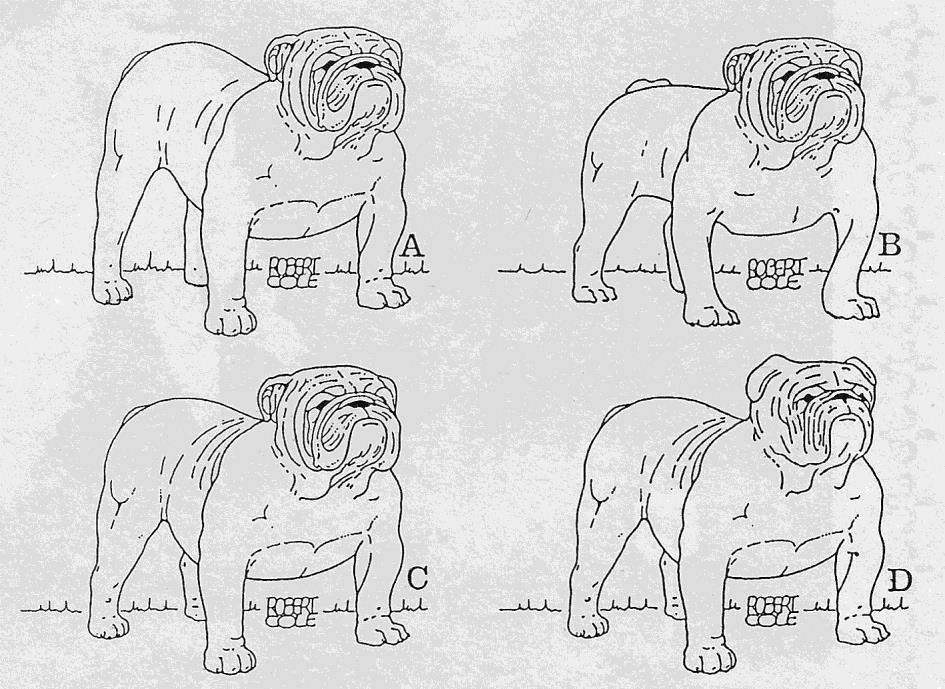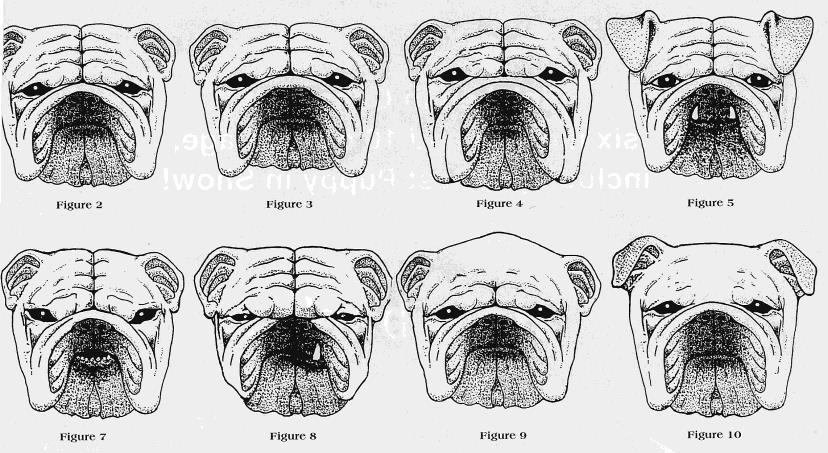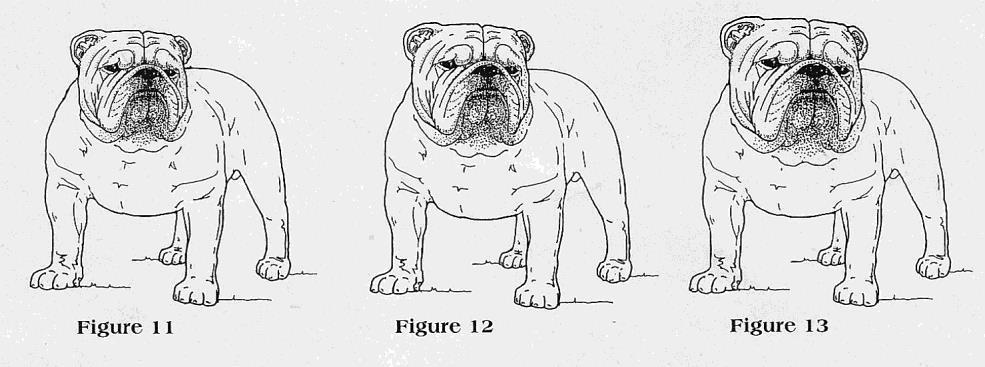YOU BE THE JUDGE
By Robert Cole From Dogs in Canada, September 1989THE BULLDOG
The current Bulldog standard is one of the few guidelines that has retained a scale of points. The total number of points is 100. These 100 points have been allotted to 28 Bulldog characteristics. Based on the number of points given to each characteristic, it is possible to use this scale to substantiate decisions as to first, second, third and fourth place Open Dog.
General Properties Head Body, Legs, etc. Proportion & Symmetry 5 Skull 5 Neck 3 Attitude………………………….. 2 Cheeks …………………. 2 Dewlap ……………….... 2 Expression ………………………. 2 Stop ……………………. 4 Shoulders ……………… 5 Gait ………………………………. 3 Eyes and eyelids ………. 3 Chest …………………… 3 Size ………………………………. 3 Wrinkle ………………… 5 Ribs …………………….. 3 Coat 2 Nose 6 Brisket 2 Colour of coat …………………… 4 Chops …………………. 2 Belly ……………………. 2 Total 22 Jaws 5 Back 5 Teeth ………………….. 2 Forelegs and elbows ….. 4 Total 39 Hind Legs ………………. 3 Feet 3 Tail ……………………… 4 TOTAL: 100 Total 39

This is an obviously exaggerated breed with many unorthodox features, and we are advised by those knowledgeable in the breed that, as Bulldog non-specialists, we should look for an overall well balanced animal. Finding the best overall well balanced animal in this Open class of four dogs will not cause you much difficulty. It will be a pleasure to describe his virtues in detail – however, what about second, third and fourth place?
FIRST PLACE
Goes to Dog C, with a total of 98 points. I took two points off because solid white is the third of the six preferred colours. Assuming this dog would move well, I have given him the full three points for gait.
This 50 lb mature male (mature bitches weigh about 40 lbs.) conveys an impression of great stability, vigour and strength due to his heavy, thickset, low slung body, massive short faced head, wide laid back shoulders and sturdy limbs.
This dog’s head and face is correctly covered with heavy (not ropey) wrinkles. The skull is large, broad, flat and square. The head is deep. The cheeks are well muscled, well fleshed and extend sideways beyond the eye placement. You can measure the stop between the eyes by how far your thumb can sink into it; the depth should be sufficient for the completely black nose to be laid back at nearly 40 degrees to the horizontal.
The very dark eyes are set wide apart and as far away from the ears as possible and level with the stop. An imaginary line drawn across the face would touch all four corners of the eyes. I have drawn what I consider to be the correct eyelid shape.
The ears contribute to expression and I have drawn them small, thin, carried thrown back (rose ear) following the contour of the head and adding to its breadth by having them set high and wide apart. The muzzle is blunt, broad and turned upward, deep from the outer corner of the eye to the corner of the mouth. The upper lips swell as they approach the sides to become broad, thick and completely cover the undershot jaw.
The chest is very broad, deep and full. The forelegs are short, stout and muscular, set wide apart and well out from the body, the well developed forearms giving the straight legs the appearance of a bowed outline. The shoulders are muscular, heavy, sloping, very powerful and give the appearance of being tacked on.
There is a slight fall to the short back close behind the shoulders, and then the topline rises to the higher-than-shoulders croup, curving down again more suddenly to the low-set tail, producing the characteristic roach back. The loins are comparatively narrower than the shoulders. The belly is tucked up. The hind legs are longer in proportion than the forelegs so as to elevate loins above the shoulders. The hocks are slightly bent, well let down and approach each other; the feet and stifles turn slightly out.
SECOND PLACE
Based solely on the official scale of points and totaling the numerical value of each part of the head separately, Dog a would be given second place. I have him 39 points for a good head. I took 10 points off because of his inferior hindquarters. I took off a total of 10 more because he is white, his gait would be poor and he was not symmetrical, for a remaining total of 80 points.
THIRD PLACE
Even though my third place dog has a poor head (the ears are too thick and heavy and the muzzle lacks fullness due to the absence of cheek cushion), each of the remaining parts of Dog D’s head had to be given their allotted value for a head total of 30 points out of a possible 39.
The good front and rear receive a full 39 points; however, I could only give 10 points out of a possible 22 for General Properties because I felt that, due to muzzle loss and poor ears, proportion and symmetry were lacking. In addition, the correct expression and attitude were not present. This gave Dog D 70 points.
FOURTH PLACE
A good head and a short flat glossy coat, but the rest of Dog B departs in many ways from typical, sound though he may be. I gave the full 39 points for the good head. I could only give 17 points for Body, Legs, etc.
I could not give points for the chest, which is too narrow, as are the ribs. The brisket lacks depth, the belly lacks the tuck up a roach back would compliment. The hind legs lack the length required to position the rear higher than the shoulders and the tail is set too high.
Under General Properties, I took off five points for absence of proportion and symmetry. I interpreted ‘attitude’ as settled behavior, not posture, and, since expression was good, did not take any points off. I took off three points for gait because even if this dog moved well, he would not move well for a Bulldog. And, of course, two points off because he is not the more preferred ‘red brindle’ or ‘all other brindles’ . This left him with a total of 68 points and fourth place.
YOU BE THE JUDGE
By Robert Cole From Dogs in Canada, January 2003TEN BULLDOG HEADS
Based on the current CKC Breed Standard
SELECT ONE
You are invited to determine which one of these 10 face-on Bulldog heads represents correct and then identify the one or more faults possessed by each of the remaining nine. Searching for and identifying these faults is an excellent way to strengthen your appreciation for this most complex of canine heads.


FIGURE 1
This head has only one fault – the eyes are spaced too far apart. The eyes should be wide apart, but the outer corners should be well within the outline of the cheeks.
FIGURE 2
This is the correct head. The shape of the eye (eyeball) is required to be round, and it is, however; the eyelids give a more almond shape to the visible portion of the eye. As for the rest of the head, each virtue can best be appreciated by searching for and identifying each departure from correct on the remaining eight heads. Take Figure 3, for instance.
FIGURE 3
This head departs from correct in two ways, one more immediately noticeable than the other; The more noticeable fault is a lack of deep underjaw. The standard advises, “Jaws massive, very broad, square” and the skull appears “very high, from the corner of the lower jaw to the apex of the skull”. Less noticeable is the nose fault. The standard reads, “Nostrils should be wide, large.” The importance of wide-open Bulldog nostrils cannot be overemphasized. Figure 3’s nostrils are closed to mere slits, which makes breathing difficult.
FIGURE 4
This higher-than-wide head has two faults. The eyes and stop are not on the same horizontal plane. An imaginary horizontal line intersecting the four corners of the eyes should just about rest on top of the nose. This Bulldog’s eyes are positioned too far above the nose, producing an expression foreign to this breed. The second fault is a narrow muzzle – even though the cheeks are broad.
FIGURE 5
Three faults are present. The correct ear is a rose ear folding inward at its back, with the upper or front inner edge curing outward and backward, showing part of the inside of the burr – not the button ear topping this dog’s head. (The ear leather should also be thin.) the eyes should not show white when looking directly forward. The teeth should not be seen when the mouth is closed.
FIGURE 6
The two faults here both relate to a requirement that when viewed from the front, the various properties of the face must be equally balanced on each side of an imaginary line down the centre. This line is composed of the furrow down the centre of the forehead, the line down the centre of the nose, then the philtrum or fissure down the centre of the upper lip. The first indication that features on this head are not equal on both side s of the line is the smaller right eye. The second indication that all is not well is the slant over to our left, of the line running from the nose to the chin.
FIGURE 7
The narrow skull has positioned the eyes obliquely on the sides of the head. The lack of skull width has narrowed the muzzle and produced a faulty bite. The six lower incisors between the canines should be in an even row, not in a curve. Not only are the lower incisors exposed, the narrow underjaw is in the shape of a spoon.
FIGURE 8
This head has three faults. The first fault is large ears. The second fault is eyes that have become narrow slits because of the weight of the too heavy forehead overhang. The third fault is a wry mouth, even though the perpendicular line down the centre of the nose and the upper lip has not been affected. Seeing one lower canine is an indication that the jaw may be twisted out of line in two directions. When viewed from the front, the underjaw should be directly under the upper jaw and parallel.
FIGURE 9
This dog’s skull is domed and the ears are set on too low. The ears should be set on high, the front edge of each ear joining the outline of the skull at the top corner. They should be as far away from the eyes as possible.
FIGURE 10
This head has three faults, the lowest on the head is the least noticeable. The standard asks for the skin on the forehead to be looser and to wrinkle, and for the broad, deep furrow to extend to the apex of the skull. This head lacks both wrinkle and furrow. Second and least noticeable is the long (deep) upper lip, which further alters expression. Third is the faulty high-set ears.
HEAD SIZE
By now you have an appreciation for this most complex canine head; however, there is still the controversial question of ideal head size. The requirement that the circumference of the skull “in front of the ears should measure at least the height of the dog at the shoulders.” Suggests three sizes. Breeder G. William Andree remarked in the November 29, 1980 issue of Canine Chronicle that “Taken literally, this means that the ideal head need not measure more than 15 or 16 inches, which happens to be the height at the shoulders of the tallest specimens in the ring today. I don’t need to tell those of you who are familiar with head sizes that a 15 inch skull on a Bulldog of that size would look like a peanut!” The head size on Figure 11 is close to 16 inches, Figure 12 is close to 20 inches and Figure 13 is massive. The choice is yours.

